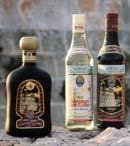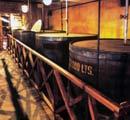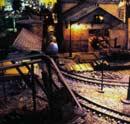Cuba’s RumTouched by the Centuries
Nobody had ever written, not even in primitive chronicles, about that colorless and burning water that drowned people's sorrow and maddened Hispanic conquistadors and enslaved Indians working in the first mills of the 16th century that used to squeeze a dark-brown sugar out of the slender canes and reeds that Christopher Columbus had brought to the New World. At the time –as it still happens now- there were rustic ceramic barrels to keep that strong sugarcane spirit. African slaves used to pour the first sip on the floor as a token of good fortune. Five centuries later, Cubans still follow the same funny ritual of devoting the first drink of the bottle to the African-Cuban deities. No matter the brand or the price, and no matter whether is silver dry or golden aged rum.
At the onset, that rough sugarcane spirit became the first substitute of the barreled wine being shipped from Spain in galleons, the same wine that the smoldering tropical heat and the choppy waters of the Atlantic Ocean sometimes turned into pure vinegar. That was a thick and hard-to-swallow beverage that used to burn anybody's throat and conquered the first sugarcane plantations, roadside taverns, seaports, docks and even the fanciest mansions of well-heeled white masters.
Today, even that rough sugarcane spirit that many pour onto the floor in tribute to the gods is distilled and marketed under the Santero trademark. This is a top-of-the-line product that sells overseas as made-in-Cuba rum. Santero is used to mix cocktails named after such Orishas as Chango, Babalu-Aye, Yemaya and other deities. Nowadays, traditional sugarcane rum (catgut) –like Santero- is still widely used, either straight or mixed with coconut milk, lemon, sugar, ice cubes and… bingo! That's an exquisite saoco, the same beverage that some people used to prepare surreptitiously during the tough times of the colonial rule.
There's no doubt that the reputation of that primitive sugarcane rum that harks back from the Spanish colonial rule –called either tafia or drake- was closely bonded to peppermint. The emergence of rum, therefore, is knit to slavery in Cuba and in the Caribbean, and also linked to the practice of Santeria. The beverage served also as the main fuel for the humble ovens of black men and women for more than four centuries. The white settlers, who came to Cuba with a warmongering aftertaste following the recapture of the Iberia Peninsula, certainly laid down hoes and machetes to hack off sugarcane. The trade of African slaves, therefore, suited them to the ground for it meant a cheap and no-sweat way of growing sugarcane and producing sugar, alcohols, spirits and rum.
The story goes that those beverages that used to burn any drinker's mouth and throat, took a pinch of sugar and a twig of peppermint for the good health of the body and soul in the 18th and 19th centuries, long before the invention of ice. Sugarcane spirit was good to make black people forget, to get high and go crazy. But it wasn't good enough to make black families free.
But, hold your horses! A century ago, rum as we know it now was not a commodity in Cuba. Not even in the dawn of the great sugar expansion of the early 19th century people knew about rum. A fact that proves that rum was only small-fry sugarcane spirit and it was in high demand in Cuba and in the rest of the Caribbean happened when Gelabert started growing the first coffee plants in Wajay, in the outskirts of Havana, in the last third of the 18th century. His primary intention was far from using coffee grains to brew that sour, strong and piping-hot infusion that brings so much delight now. He'd begun sowing the seeds to make catgut because a hot cup of coffee was not yet known in the chats of the 1800s. Some people preferred hot chocolate; others were simply guzzling straight catgut. Perhaps the alembics that came later to the island served to get rid of that reeking smell and strong taste of raw unfermented honey that catgut used to have in the past. Or maybe it was already a ballroom drink.
However, the development of the sugar-making industry was undeniable. More African slaves were dragged into the plantations. Steam engines were introduced to mill sugarcane. High-output technology was being installed. The number of sugar mills exploded with better technology and with the introduction of the latest scientific breakthroughs at the time. Railroad trains were chugging their way from the plantations to the mills and sugar was being boxed and exported in crates. Free market policies let some U.S. investment in and the French enlightenment was in full swing. And, by the way, ice had finally appeared.
American impresarios, who first attempted to re-colonize the province of Matanzas during the domain of the Spanish crown on the island, cooked up a system whereby each plantation was going to be checkered in 40 acres that were supposed to feed just one sugar mill. That endeavor officially teed off in the early 19th century in Matanzas, the province of the great farming lands.
In Cuba's free jungles, where the Liberation Army was calling the shots, fighters used to drink their famous canchancharas to quench the thirst. That was nothing but a combat cocktail made of sugarcane spirit, a little bit of lemon and honey that was most of the time drunk on the run. In the late 19th century, in an ore mine near Santiago de Cuba, the first daiquiri was mixed with a blend of silver dry rum, lemon, a pinch of sugar and crushed ice.
The end of slavery eventually came to pass and Chinese laborers settled down on the island. American companies stormed in and bought plenty of land at very low prices, trading on the devastation left by the independence war and the 1898 U.S. military intervention. Bananas for export set in. Mineral deposits and more railroad tracks popped up everywhere. And more sugarcane was being grown, too. Huge areas of unexplored forests were felled to make way for more sugarcane as poor wetbacks from the West Indies were already trickling in. Well-off tourists flocked the island, some of them flown aboard a hydroplane from the U.S. all the way to Havana's Atares Cove. These were the ones that made the demand and price tag of on-the-rock cocktails and rum skyrocket, even though in the beginning the finest cocktails were imported from New York and Europe.
Fancy bars dotted the capital. The rough sugarcane spirit (remember the catgut?) was dumped and the more refined golden aged rum stole the spotlight, rubbing elbows with the likes of cognac and scotch. The full-fledged Cuban market, at the time brimming with exports, kept that new, emerging rum afloat. In Santiago de Cuba circa 1862, a Catalonian man named Bacardi had bought off the warehouses of a Briton called John Nunes. The homemade sugarcane rum eventually swept the imported grapes off their feet and got a grip of low purchasing power markets. Even Mexico started importing sugarcane rum from Cuba.
The national rum-making industry left that pre-industrial stage behind and began bottling rum. In Cardenas, state-of-the-art alembics built by a Basque man named Arrechabala were all the rage. But a new distillery was founded in Santa Cruz del Norte in 1919 in an effort to make much better rums that soon hit the shelves in Cuba and tubs in the U.S. during the much-feared Prohibition Act. Scores of crates were then smuggled out of Cuba's northern coast into the United States as the island nation's coastguard chiefs were looking the other way. The Italian mafia played a supportive role in the operation.
Stranded by crises and wars, the expansion of rum was gradually gauging demand and growth. The national market was once again limited to that poor sugarcane spirit and cheap rums that small and midsize factories began to produce. Everybody knew Cuba could make higher quality beverages, but those good intentions were only used to pave roads. Only deep-pocket Americans could afford the fanciest drinks and the best rum that Cuba used to produce in limited quantities. Time stood still until the 1959 Revolution, a process that was won without saoco or rum and peppermint.
That was the time when the Cuba rum-making strategy finally kicked in for the first time in its entire five-century-old history. The driving force that moved this effort was no other than the intention to get off from behind the competitive eight-ball, both in the turf and overseas. Quality was then the basis for a quick takeoff and further expansion. That definition was put on the line in a big way with the emergence of Havana Club, the rum that put Cuba back on the map as a top-drawer spirit maker. Several excellent brands stuck around for years and others have even lived out time. But now Cuban distillers know the ropes and work in a coherent and orderly fashion. Little by little, they've set up their own quality verification systems.
In today's world, there is no better way to nudge into the international markets. And now we come to Mulata and Santero rums, two brands produced by Cuban company Tecnoazucar that are up to par with the best spirits of their kind in the world and that are now beginning to flex their muscles. Havana Club's three-year-old aged silver dry rum, and the five- and seven-year-old golden aged rums (made in the Santa Cruz del Norte and George Washington distilleries in Havana and Villa Clara, respectively) are sold inside Cuba, especially in tourist resorts that today welcome nearly two million foreign sunbathers every year, and in dollars-only stores.
Other top-tier rums, including some old and well-known brands, are waiting for their low-key distilleries to be finally upgraded and for roomier cellars, as well as for more advanced bottling systems in line with today's trade requirements. A case in point is the loved and sought-after Paticruzado (The Sailors), Bucanero and other that have begun to roll out on conveyer belts from factories that are usually located near sugar mills and alcohol processing plants. Cuba's sugar-making industry, forced to undergo severe reshufflings and overhauls lately, has mapped out new working lines for sugarcane spin-offs. And one of those byproducts is no other than rum. The distilling of higher quality alcohols, sugarcane spirits and rums is now a priority.
Tourism's leapfrogging growth pace over the past decade has made hotel infrastructure boom. The intake of good-quality rum in the country has gotten a new lease on life, chiefly in the form of some of the most coveted homemade and international cocktails. That, too, is putting the gas on demand.
I still can remember actor Gene Hackman's performance in The Firm. When he tried to lay his hands on the beautiful girl he had invited to Grand Cayman, he started praising the values of Havana Club's Golden Aged Reserve Rum, comparing it to a superb European brandy or a good scotch. The tradition of “pouring some rum on the floor for the saints” –that came into being as a religious tradition in black slaves' Cuba- is now practiced in many places by both rookie and veteran drinkers, just like the African cutters used to do.
Today, however, Cuban rums don't need a twig of peppermint to find Eleggua's pathway. Its extraordinary quality is the key to success.
Havana Club in the world… and in Cuba! Havana Club (HC) is Cuba's bestselling rum brand all over the world. Last year's figures really pack a wallop: two million cases of 9-lt. bottles and the number 50 notch among the planet's bestselling rums, according to Impact magazine. And all this has happened a decade after the foundation of Havana Club International, the Cuban-French joint venture partnered by Cuba Ron and Pernod Ricard, that saw the light of day in 1990 to guarantee the distribution of this exquisite beverage. The supreme quality of these rums has since then made the company average an annual 17 percent growth during those first ten years in the world market. In Cuba, HC is the leading brand as far as sales are concerned. Today, its silver dry and golden aged rums are found in over a hundred countries and counting, with the sole exception of the U.S. due to the trade embargo imposed on Cuba. As we speak, a spanking-new and refreshing cocktail that combines HC's silver dry rum and tropical fruits (Havana Loco) is shattering all demand expectations and setting new record highs in sales in Europe and Cuba. And it seems Havana Loco is not ready to hit the brakes, yet.




































































